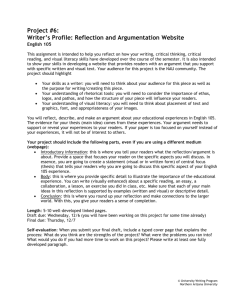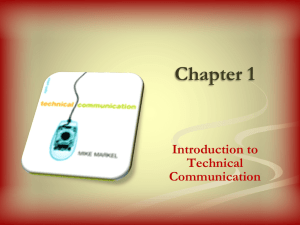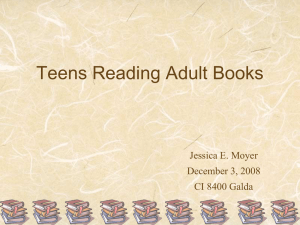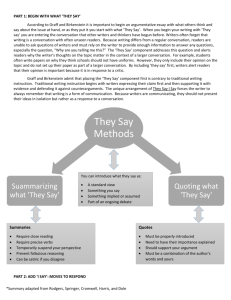Researched Position Paper Assignment - English II PAP
advertisement
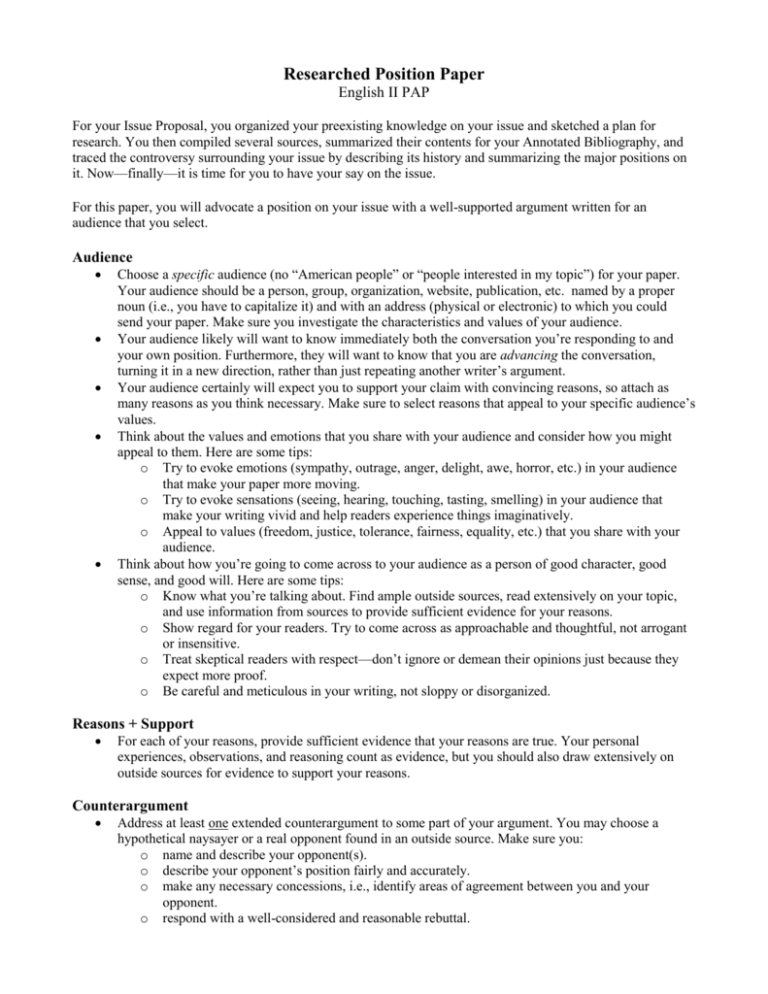
Researched Position Paper English II PAP For your Issue Proposal, you organized your preexisting knowledge on your issue and sketched a plan for research. You then compiled several sources, summarized their contents for your Annotated Bibliography, and traced the controversy surrounding your issue by describing its history and summarizing the major positions on it. Now—finally—it is time for you to have your say on the issue. For this paper, you will advocate a position on your issue with a well-supported argument written for an audience that you select. Audience Choose a specific audience (no “American people” or “people interested in my topic”) for your paper. Your audience should be a person, group, organization, website, publication, etc. named by a proper noun (i.e., you have to capitalize it) and with an address (physical or electronic) to which you could send your paper. Make sure you investigate the characteristics and values of your audience. Your audience likely will want to know immediately both the conversation you’re responding to and your own position. Furthermore, they will want to know that you are advancing the conversation, turning it in a new direction, rather than just repeating another writer’s argument. Your audience certainly will expect you to support your claim with convincing reasons, so attach as many reasons as you think necessary. Make sure to select reasons that appeal to your specific audience’s values. Think about the values and emotions that you share with your audience and consider how you might appeal to them. Here are some tips: o Try to evoke emotions (sympathy, outrage, anger, delight, awe, horror, etc.) in your audience that make your paper more moving. o Try to evoke sensations (seeing, hearing, touching, tasting, smelling) in your audience that make your writing vivid and help readers experience things imaginatively. o Appeal to values (freedom, justice, tolerance, fairness, equality, etc.) that you share with your audience. Think about how you’re going to come across to your audience as a person of good character, good sense, and good will. Here are some tips: o Know what you’re talking about. Find ample outside sources, read extensively on your topic, and use information from sources to provide sufficient evidence for your reasons. o Show regard for your readers. Try to come across as approachable and thoughtful, not arrogant or insensitive. o Treat skeptical readers with respect—don’t ignore or demean their opinions just because they expect more proof. o Be careful and meticulous in your writing, not sloppy or disorganized. Reasons + Support For each of your reasons, provide sufficient evidence that your reasons are true. Your personal experiences, observations, and reasoning count as evidence, but you should also draw extensively on outside sources for evidence to support your reasons. Counterargument Address at least one extended counterargument to some part of your argument. You may choose a hypothetical naysayer or a real opponent found in an outside source. Make sure you: o name and describe your opponent(s). o describe your opponent’s position fairly and accurately. o make any necessary concessions, i.e., identify areas of agreement between you and your opponent. o respond with a well-considered and reasonable rebuttal. 2 Organizing Your Paper You’ll want to organize your paper in the manner you think will prove most effective with your audience, but here are some general guidelines: Introduction o Indicate at the beginning of your paper what larger conversation you’re writing in response to. o Then state a thesis that includes your claim and reasons. Regardless of how interesting a topic may be to you as a writer, readers always need to know what is at stake in a text and why they should care. Rather than assume that audiences will know why their claims matter, all writers need to answer the “so what?” and “who cares?” questions up front. Remember, this piece is unsolicited, which means you must work hard to demonstrate why your issue matters and to attract readers. Providing compelling answers to the “so what?” and “who cares?” questions is crucial. Style You’re writing for a highly specific audience, so avoid writing to some vague, generalized reader. When reading your paper, it should be obvious that you’re writing to the audience you’ve identified. All readers appreciate coherent, unified paragraphs, so your paragraphs should include a topic sentence that clearly states the main idea of the paragraph and supporting sentences that cluster around the main idea without detours. Document your sources properly according to MLA style. Proofread carefully; avoid errors in grammar, spelling, punctuation, and mechanics. Other Requirements Your paper should be 5-6 full pages (not including the works cited page). Anything shorter or longer will be considered a failure to adhere to one of the assignment’s basic requirements. It should be double-spaced, typed in Times New Roman font, with 12-point character size and one-inch margins all the way around. Your rough draft is due at the beginning of class on Feb.3/4 and you should think of it as a final draft— something that is ready to be read by your intended audience. If your rough draft does not meet every requirement of this assignment sheet, I will return it to you and count it as a zero. Peer reviews: Feb. 3/4 Final drafts are due Feb. 9/10


